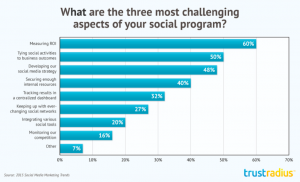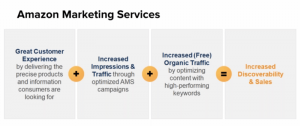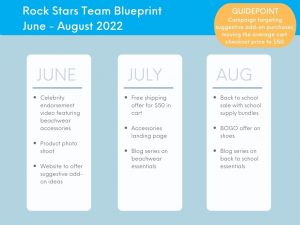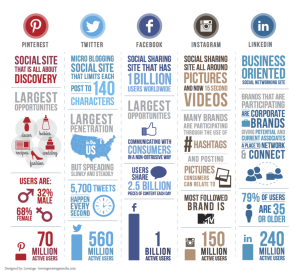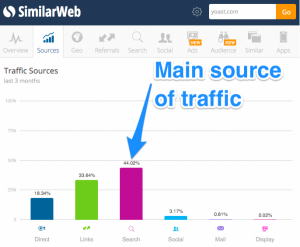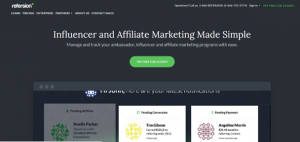Index:
- Conquering Content Marketing in 5 Steps: It All Starts With a Plan
- Conquering Content Marketing, Step 2: The Content (and Plot) Develops
- Conquering Content Marketing, Step 3: Facing the ‘Fans’
Lisa Hughes, British Outfitters’ most recent New York hire, was sitting in the office of her boss, Don Makerfield, anxiously waiting for him to get off the phone. Earlier that day, Don asked Lisa to develop a content marketing strategy that would help British Outfitters penetrate the highly competitive U.S. teen fashion market. It didn’t take Lisa long to come up with an idea that she knows Don will love. As he wraps up his phone call, let’s see what he thinks …
The Conversation
“Is that so?” Don said dryly into the receiver. He looked over at Lisa who gave a polite smile.
“Have you tried setting the thing on fire?” he asked with a sarcastic grin. “All right, look, I’ve got someone in my office. I’ve got to go… What can I do for you, Lisa?”
“Well, Don. I’ve been thinking about our marketing campaign, and here it is! What’s the one thing all girls want, but they can never have?”
Don thought about this a moment, repeating the last phrase quietly to himself. “I don’t know, what?” he asked.
“A perfect body! All girls want a perfect body, but it’s unattainable. There is always something that can be improved. Here’s what I’m thinking …”
Before Lisa could complete her thought, Don cut her off. “I know exactly where you’re going with this, Lisa, and I like it! I can see it now, a huge billboard showing super-thin models in our tightest jeans with the words, ‘British Outfitters – The Perfect Jeans for the Perfect Body.’ Girls will buy our jeans to show the world that they’ve finally achieved the perfect figure.”
Lisa looked at Don, dumbfounded. “Um … I was actually thinking about taking it in the opposite direction. Let’s rebel against the image of super-skinny models! We should meet our customers on their terms with a message like, ‘You’re perfectly you, and so are our jeans.’ Maybe get real teen girls to tell their story of why they’re happy with who they are, not who the media says they should be. We can post videos, do a print and social campaign, and create a positive image for our brand.”
Don looked at Lisa in surprise. “Hm … That’s … an idea.” Don weighed both ideas in silence; Lisa prayed he wouldn’t go with his direction. No such luck.
“OK,” said Don, “We’re going with my idea. You have $20,000 for the photo shoot – make sure to get really skinny models – and $80,000 for advertising. The creative team will organize the shoot but I want you to oversee it. Maybe record some behind-the-scenes footage for our blog or whatever. Now, I’m late for a conference call, but keep me in the loop on the campaign’s progress. And I want that billboard!”
Shell-shocked, Lisa slowly and numbly exited Don’s office. “Right …”
The Billboard
Over the next few weeks, Lisa supervised the shoot, negotiated ad buys on the sites Don told her to advertise on, and she even got Don’s billboard produced, despite many heated arguments about why his concept was so misguided. Consumers were about to tell him the same thing.
Two Weeks In
The campaign had been live for about two weeks, and it wasn’t going well at all. British Outfitters burned through almost $10,000 on display ads that brought just a few thousand visitors, and hardly any conversions.
Although there was no way to tell if the billboard was doing anything, Lisa was pretty sure it wasn’t because sales were dismal across the board. Lisa’s team wrote on the company’s blog almost every day, but it was a ghost town, and the only social activity was from a group of conservative moms who criticized the ads as too provocative, which they were; Don had made sure of it!
It was right about then that the consumers decided to create some British Outfitters content of their own.
One Thursday, British Outfitters’ Twitter account started to light up. Some of the angry moms organized a live protest outside a one of British Outfitters’ retail locations. Soon after, images of Don’s billboard being vandalized started circulating on social platforms and around the blogosphere.
It started with a few protesters tweeting pics of the billboard with the hashtag #BOboycott. The tweets made their way into a popular mommy blogger’s TweetChat, which shifted the topic to British Outfitters. Soon #BOboycott was trending worldwide. The conversation then jumped to Reddit, where Don’s “The Perfect Jeans for the Perfect Body” line found its way onto some distasteful memes. The memes hit Tumblr and Pinterest in force, prompting bloggers to churn out exaggerated stories without any real fact checking.
It was frustrating, but there wasn’t much Lisa could do. She checked in with the social group before leaving for the day, and they were in full crisis management mode.
Don’s door was closed so Lisa called it a night, wondering what tomorrow would look like. On her way out she noticed a police car parked across the street. Could things be that bad that their office needed protection?
The next morning Lisa walked into a war zone. People were running around, papers were flying off desks, phones were ringing with nobody to answer them.
At her desk she saw close to 150 new emails and thousands of tweets pouring into British Outfitters’ Twitter channel. A major gossip blog had gotten hold of a few internal emails containing highly distasteful comments about the type of people who British Outfitters’ management did and did not want wearing their clothing. This fueled the fire under the conservative moms who were now close to rioting at the retail stores. To add insult to injury, someone had set fire to Don’s billboard the night before, and people were taking pictures of the flaming billboard from the highway!
Lisa saw that Don’s office door was still closed and his light was off. She turned to her co-worker, Mike, to ask about Don, but he was too busy dealing with website instability to give her an answer. The PR crisis was sending surges of traffic to their website; Mike and his team were now playing triage nurse to their small network of underpowered web servers.
Without Don around, Lisa needed to step up and make some quick decisions. All ad campaigns were immediately paused, and budgets were shifted to Twitter and Facebook to try and control the messaging.
Working with the PR and creative teams, she put up a quick landing page on the site where they could acknowledge the situation and answer questions. The whole day was like that, putting out fire after fire, trying to just get through the nightmare.
30-Second Commercial Break

Let’s pause the story to consider how British Outfitters’ PR disaster plays a role in our five-point content marketing framework.
Content creation, the second step in the framework, cannot always be controlled by your brand. Sometimes consumers ignore your content, sometimes they react to it the wrong way, and sometimes they take over the conversation with their own version of your message.

Whether we like it or not, consumer-generated content can be extremely powerful. It’s created quickly, cheaply, and it’s twice as trustworthy as content that lives on a brand’s website.
Look at the difference in trust between the content brands post themselves on social networks (15 percent trusted in the U.S.) and consumer-generated reviews on Amazon and YouTube (70 percent trusted in the U.S.).
If you’re spending a lot of energy creating content on social networks to drive consumers to your website, you’re spinning your wheels. Not only will a tiny fraction of your audience actually see your posts, but of the ones that do only 15 percent trust your message. Instead, you’re far better off spending your energy persuading consumers to talk about you and your products on your behalf.
“How does one do that?” you ask.
- Get your product in consumers’ hands: If you’re new to the market, send free samples to bloggers and influencers. If your product has been in the market for a while, give coupons to customers who review your product on Amazon or YouTube.
- Treat customers like royalty: Deliver amazing customer service. Expedite their shipping. Offer a free add-on with their order.
- Engage with them on an individual level: Strike up a friendly conversation with a few loyal customers on Twitter. Send a personal follow-up email to ask them their opinion.
- Help them without expecting anything in return: Look for consumers who are having trouble online. If your product can solve their problem, send them a free sample. If it can’t, point them in the right direction, even if it’s toward a competitor.
- Meet customers in person: Attend local meet ups and events. Get to know them on a first-name basis.
- Make yourself available: Don’t make consumers come to your site to contact you. Go where they are: Facebook, Twitter, LinkedIn, Google+, Pinterest, Vine, Instagram, forums, etc. You don’t need to spend a ton of time on every platform, but you do need to be accessible there.
If you find yourself in some hot water, like British Outfitters, try to get in front of the situation. Address the problem, apologize, and try to patch things up quickly. Listen to consumer feedback, thank them for their input, and show them that you’re using it to improve your product, service, or message.
Now back to our story…
The Weekend
Lisa had never been more grateful for a Saturday off in her life. She felt bad for the PR teams who were undoubtedly “earning their keep” this weekend. Around lunchtime she received a text from Mike.
“Lisa, it’s Mike. Did you hear Don’s in the hospital?”
Lisa almost choked on her salad. “No! What happened!” she pounded out.
“Not sure. We’ll find out Monday I guess,” he responded.
Thirty minutes later Lisa’s phone started to vibrate. It was a call from the UK.
“Hello?”
“Hi, is this Lisa Hughes?”
“This is she.”
“Hi, Lisa, this is Holly Spaulding from the British Outfitters corporate office. I’m Don’s supervisor. Do you have a few minutes?”
To Be Continued…
Next article: Facing the Fans
(772)
